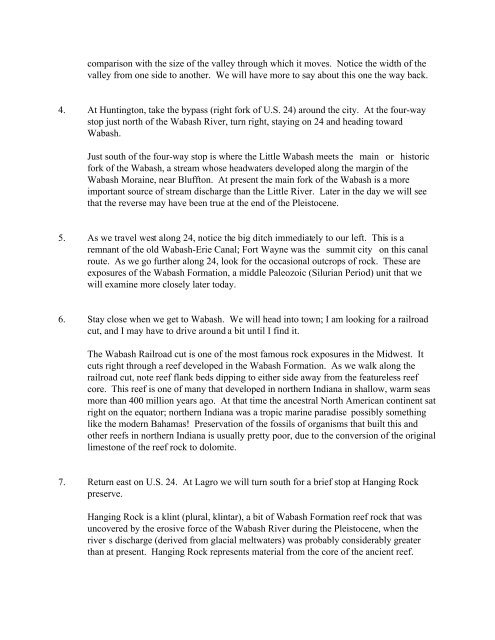G100 Field Trip: Bedrock and Surficial Geology of Fort ... - IPFW
G100 Field Trip: Bedrock and Surficial Geology of Fort ... - IPFW
G100 Field Trip: Bedrock and Surficial Geology of Fort ... - IPFW
You also want an ePaper? Increase the reach of your titles
YUMPU automatically turns print PDFs into web optimized ePapers that Google loves.
comparison with the size <strong>of</strong> the valley through which it moves. Notice the width <strong>of</strong> thevalley from one side to another. We will have more to say about this one the way back.4. At Huntington, take the bypass (right fork <strong>of</strong> U.S. 24) around the city. At the four-waystop just north <strong>of</strong> the Wabash River, turn right, staying on 24 <strong>and</strong> heading towardWabash.Just south <strong>of</strong> the four-way stop is where the Little Wabash meets the main or historic fork <strong>of</strong> the Wabash, a stream whose headwaters developed along the margin <strong>of</strong> theWabash Moraine, near Bluffton. At present the main fork <strong>of</strong> the Wabash is a moreimportant source <strong>of</strong> stream discharge than the Little River. Later in the day we will seethat the reverse may have been true at the end <strong>of</strong> the Pleistocene.5. As we travel west along 24, notice the big ditch immediately to our left. This is aremnant <strong>of</strong> the old Wabash-Erie Canal; <strong>Fort</strong> Wayne was the summit city on this canalroute. As we go further along 24, look for the occasional outcrops <strong>of</strong> rock. These areexposures <strong>of</strong> the Wabash Formation, a middle Paleozoic (Silurian Period) unit that wewill examine more closely later today.6. Stay close when we get to Wabash. We will head into town; I am looking for a railroadcut, <strong>and</strong> I may have to drive around a bit until I find it.The Wabash Railroad cut is one <strong>of</strong> the most famous rock exposures in the Midwest. Itcuts right through a reef developed in the Wabash Formation. As we walk along therailroad cut, note reef flank beds dipping to either side away from the featureless reefcore. This reef is one <strong>of</strong> many that developed in northern Indiana in shallow, warm seasmore than 400 million years ago. At that time the ancestral North American continent satright on the equator; northern Indiana was a tropic marine paradise possibly somethinglike the modern Bahamas! Preservation <strong>of</strong> the fossils <strong>of</strong> organisms that built this <strong>and</strong>other reefs in northern Indiana is usually pretty poor, due to the conversion <strong>of</strong> the originallimestone <strong>of</strong> the reef rock to dolomite.7. Return east on U.S. 24. At Lagro we will turn south for a brief stop at Hanging Rockpreserve.Hanging Rock is a klint (plural, klintar), a bit <strong>of</strong> Wabash Formation reef rock that wasuncovered by the erosive force <strong>of</strong> the Wabash River during the Pleistocene, when theriver s discharge (derived from glacial meltwaters) was probably considerably greaterthan at present. Hanging Rock represents material from the core <strong>of</strong> the ancient reef.


